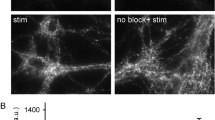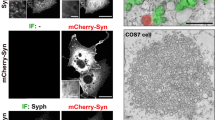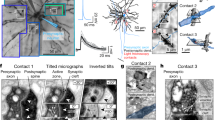Abstract
THE synaptic junction is the intercellular contact where bioelectrical impulses are transferred and transformed by neurotransmitters. The molecular mechanism of impulse transformation is still largely unknown. To understand this process, a detailed knowledge of the structure of the synaptic apparatus is essential. The available information on the morphology and cytochemistry of synapses has recently been reviewed1. To arrive at a more precise morphological characterisation of the synaptic junction with respect to carbohydrate moieties2,3, we investigated the capacity of the plant lectins concanavalin A (con A) and ricin, labelled with ferritin4, to bind to isolated synaptosomes (that is, pinched-ofT axon terminals) and synaptic junctions.
This is a preview of subscription content, access via your institution
Access options
Subscribe to this journal
Receive 51 print issues and online access
$199.00 per year
only $3.90 per issue
Buy this article
- Purchase on Springer Link
- Instant access to full article PDF
Prices may be subject to local taxes which are calculated during checkout
Similar content being viewed by others
References
Pfenninger, K. H., Progr. Histochem. Cytochem, 5, 1–86 (Gustav Fischer Verlag, Stuttgart, Portland, 1973).
Rambourg, A., and Leblond, C. P., J. Cell Biol., 32, 27–53 (1967).
Meyer, W. J., J. Cell Biol., 43, 92a (1969).
Hirano, H., Parkhouse, B., Nicolson, G. L., Lennox, E. S., and Singer, S. J., Proc. natn. Acad. Sci. U.S.A., 69, 2945–2949 (1972).
Levitan, J. B., Mushynski, W. E., Ramirez, G., J. biol. Chem., 247, 5376–5381 (1972).
Lowry, O. H., Rosebrough, N. J., Farr, A. L., and Randall, R. J., J. biol. Chem., 193, 265–275 (1951).
Cotman, C. W., and Taylor, D., J. Cell Biol., 55, 696–711 (1972).
Stobo, J. D., and Rosenthal, A. S., Expl Cell Res., 70, 443–447 (1972).
de Petris, S., and Raff, M. C., Eur. J. Immun., 2, 523–535 (1972).
Nicolson, G. L., and Blaustein, J., Biochim. biophys. Acta, 266, 543–547 (1972).
Tomita, M., Kurokawa, T., Onozaki, K., Ichiki, N., Osawa, T., and Ukita, T., Experientia, 28, 84–85 (1972).
Millonig, G., Proc. fifth int. Congr. Electron Microscopy, Philadelphia (edit. by Breese, S. S., jun.), 2, 8 (Academic Press, New York, 1962).
Sharon, L., and Lis, H., Science, 177, 949–959 (1972).
Crichton, R. R., Angew. Chem., 85, 53–62 (1973).
Matus, A., de Petris, S., and Raff, M. C., Nature new Biol., 244, 278–280 (1973).
Author information
Authors and Affiliations
Rights and permissions
About this article
Cite this article
BITTIGER, H., SCHNEBLI, H. Binding of concanavalin A and ricin to synaptic junctions of rat brain. Nature 249, 370–371 (1974). https://doi.org/10.1038/249370a0
Received:
Issue Date:
DOI: https://doi.org/10.1038/249370a0
This article is cited by
-
Synaptic junctional glycoconjugates from chick brain
Neurochemical Research (1980)
-
Glycoprotein galactosyltransferase activity in synaptic junctional complexes isolated from rat forebrain
Neurochemical Research (1979)
-
Separation of specific fractions of synaptosomes by affinity chromatography
Experientia (1978)
Comments
By submitting a comment you agree to abide by our Terms and Community Guidelines. If you find something abusive or that does not comply with our terms or guidelines please flag it as inappropriate.



